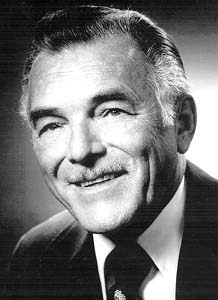
Year Born: 1916
Year Died: 2008
Year of Induction: 1986
Born in 1916, and raised on the prairies, Ernie Rose’s ambition was to become a radio operator on one of the giant luxury Empress liners that sailed around the world from the port of Vancouver. His dreams never materialized. Instead, he remained on shore to bring the world to Canada through television.
He became one of the few people in the broadcasting industry whose career led from crystal sets and spark-gap transmitters to sophisticated satellites. Like his father, Ernie became an amateur radio ham operator. In pursuit of his commercial licence, he enrolled at the Sprott-Shaw School in Vancouver. Graduating in 1934 he was ready to travel to many of the places he had got to know through amateur radio. While waiting for an opening on a ship, he and another high academic achiever accepted an offer to go to work as announcer/technicians with Sprott-Shaw’s radio station – CKMO. They split the $65.00 monthly salary of the one man they replaced but were doing the work of two men and putting in 10-to-12 hour days, 6 days-a-week. Ernie’s pal went to sea and Ernie became CKMO’s chief engineer, picking up the full $65 salary. He even found time to get married. In 1940, he left CKMO to join the CBC as an operator/ technician.
In 1947, on learning that Seattle would soon have its first TV station on the air, Ernie and a colleague set out to build British Columbia’s first video receiver from the purchase of a “carload” of war surplus radar equipment. Facing the challenge of the mountainous terrain and the 150-mile distance from Seattle, the duo managed to bring in the weak signal of KRSC-TV. One of the first TVs in Vancouver, it was a huge attraction for the neighbours.
In preparation for the CBC’s entry into TV, at the urging of his wife Jean, Ernie went to Toronto in 1953 for a training session on television. He had progressed from maintenance supervisor to assistant technical director, when he was handed the job of building Vancouver’s first privately-owned TV station – CHAN-TV – an undertaking that involved thirty thousand pieces of equipment, and research into leading-edge technology in Japan and the USA.
Then, came BCTV and the extension of service to CHEK-TV covering Vancouver Island. Ernie relied on the knowledge and contacts he’d made while extending the CBC’s reach over most of B.C. Via networking, CHAN’s TV service was extended to the Okanagan-Mainline (Kamloops, Kelowna, Vernon, Penticton) and then to the Cariboo up to and including Prince George, and finally the West Kootenays. The extension involved 30 transmitter sites and some 800 miles of microwave routing, of which 300 miles was owned by BCTV.
With a total of 113 re-broadcasting stations serving 96% of the population of British Columbia, the enormity of Ernie Rose’s undertaking can be visualized. As BCTV’s Vice- President of Engineering, his achievements were recognized and honoured in 1973 when he was presented with the C.A.B. “Colonel Keith Rogers Engineering Award” with the inscription;
“Ernie Rose, who, despite bitter winter conditions at mountain-top sites, established in four-and-a-half months four microwave and four TV broadcasting stations to serve Cariboo and Prince George areas”
While the terrestrial signal transmission used to carry the CHAN programming was reasonably satisfactory, Ernie had his sights pinned on a higher target – satellite transmissions.
In 1977, with the Hermes satellite in orbit, the DOC presented Ernie with the opportunity to conduct experiments to determine if transmission of TV signals by satellite would improve existing service in the hinterland.. Due to logistics, the Hermes experiment did not come to fruition. However, with his usual persistence, Ernie was able to slide the project over to ANIK-B satellite,among which the following were accomplished:
A) CHAN became the first Canadian private TV station to provide a full broadcast service of 155 hours of programming per week, direct to home and to Whitehorse Yukon Cable via satellite (DBS).
B) Transmitting two television channels through one transponder on the satellite, proved the capability of cutting half of the rental costs of satellite transmissions.
C) An opportunity to make a subjective evaluation of television signals transmitted on 12GHz from the satellite as they might be affected by the cloud cover and by the precipitation variations found in British Columbia, Yukon and the Northwest Territories.
One year prior to his 1981 retirement from BCTV marking 45 continuous years in professional broadcasting, Ernie Rose was presented with the Ted Rogers Sr.-Velma Rogers Graham Award – acknowledged by his peers as a singularly unique individual – one who conceives beneficial projects, and who perseveres to bring them to reality.
In 1980, Ernie received the BCAB Broadcaster of the Year Award, and in 1995 was presented with the WABE Honours Award.
On leaving BCTV, Ernie formed E.G. Rose and Associates Inc, in which he held the office of President and Senior Consultant to the broadcast communications industry.
In 1986, Ernie Rose was inducted into the CAB Broadcast Hall of Fame.
Ernest Rose died July 11th, 2008 at the age of 92, after a long illness.
